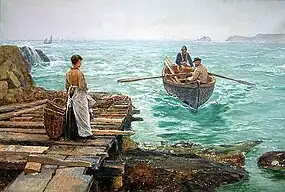Charles Napier Hemy
Charles Napier Hemy RA (Newcastle-on-Tyne, 24 May 1841 – 30 September 1917, Falmouth) was a British genre and marine painter.


He was born to a musical family in Newcastle-on-Tyne,[1] and trained in the Government School of Design, Newcastle, followed by the Antwerp Academy and the studio of Baron Leys. Hemy returned to London in the 1870s, and in 1881 moved to the coastal town of Falmouth in Cornwall. He produced painted figure- and landscapes, but his best-known works are Pilchards (1897) and London River (1904) which are in the Tate collections.
John Singer Sargent painted a portrait (now in the Falmouth Art Gallery collection) of Hemy when visiting Hemy's Falmouth home, 'Churchfield', in 1905. The visit highlighted the importance of the circle of artists that surrounded the great marine artist in the town.
Hemy was elected an Associate of the Royal Academy in 1898 and an Academician in 1910. He was also honoured as an Associate of the Royal Society of Painters in Water Colours in 1890, and became a full member in 1897.[2]
He died in Falmouth on 30 September 1917.[3]
His younger brothers Bernard Benedict Hemy (1845–1913) and Thomas Madawaska Hemy (1852–1937) were also painters, though did not match his success.[4]
References
- Grove Art article by Andrew Greg
- Chisholm, Hugh, ed. (1911). . Encyclopædia Britannica. Vol. 13 (11th ed.). Cambridge University Press. p. 265.
- "The History of Cornwall in 100 Objects". Western Morning News. 27 July 2011, p. 13.
- Greg, Andrew, "Hemy, Charles Napier". Grove Art Online. Oxford Art Online. Oxford University Press. Web. 11 Jul. 2015.
External links
72 artworks by or after Charles Napier Hemy at the Art UK site
- Tate Collection Three Hemy pictures illustrated, with notes.
- Exhibition at Falmouth Art Gallery "Hemy and friends" 24 November 2012 to 2 February 2013.
- The Falmouth Art Gallery website illustrates nine of Hemy's works.
- Bob Speel's website has additional (unreferenced) information.
- Cornwall Artists Index was more biographical information
- Works by or about Charles Napier Hemy at Internet Archive